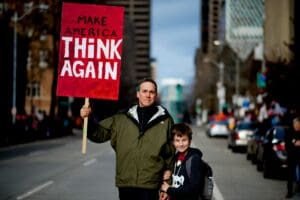BY LEA HOEFER, ERIC REINHART, AND TANYA L. ZAKRISON
Original Post: https://slate.com/news-and-politics/2022/03/how-cash-transfer-programs-prevent-violent-crime.html
Every night in Chicago, trauma surgeons face a scenario that loops on seemingly endless repeat. An individual—most often a young, Black man—is rushed into the trauma bay after suffering multiple gunshot wounds. The scene varies with each patient that is unloaded from the incoming ambulances: a collapsed lung, a pierced liver or hemorrhaging kidney, a leg with shattered bones and ripped blood vessels. Many lay limp and lifeless on our gurneys as blood loss threatens to doom surgical efforts before they’ve even begun. We can sew arteries and veins back together. We can re-expand deflated lungs. But medical interventions are neither the most important nor most difficult part of responding to Chicago’s ongoing violence.
Nearly all of our patients, if they survive, will leave the hospital only to struggle with massive hospital bills and post-traumatic stress on top of the physical hardships of recovery and disability. Most will spend their days in fear as they go home to the same disinvested environments in which they have been harmed by interwoven gun violence and poverty. In the absence of strong support and prevention systems, many of these young men will soon return to our attention—either after having been shot again or, in other cases, after having shot someone else.
Violence prevention policies in the United States have historically emphasized individualistic and often medicalized frameworks that portray violence as primarily an issue of personal morality, psychopathology, and self-control. This paradigm––which is inseparable from the ongoing pathologization of Blackness that conveniently obscures the effects of structural racism––is predicated on a willfully myopic definition of violence that accounts only for interpersonal crime while ignoring interlinked systems of harm that, in turn, fuel gun violence and crime. As a consequence, policy debates around anti-violence interventions typically ignore the avoidable injuries caused by factors like widespread poverty in the wealthiest nation on Earth, exploitative labor conditions, unaffordability of housing, war and enduring trauma for veterans, healthcare exclusion, racial and class discrimination in legal processes, abusive policing, and mass incarceration.
Instead of confronting policies that enforce inequalities from which the rich and powerful benefit, US lawmakers, political donors, lobbyists, police unions, and many academic researchers have contributed to stoking crime paranoia while insisting on individual-level interventions: from ‘mentorship’ and ‘mental health’ to punitive policing, fines, surveillance, and imprisonment.
At best, such policies obscure root causes of crime and deflect resources away from addressing these. At worst, they exacerbate the underlying drivers of America’s globally infamous violence problem.
In this context, a new policy from Chicago’s Mayor Lori Lightfoot could offer a much needed change of approach.
Lightfoot’s recently announced guaranteed basic income program will provide monthly $500 cash transfers to 5,000 of Chicago’s most in-need households in a city in which 34 percent of Black residents live below the federal poverty line.
Although this is, for now, only a small-scale pilot project, policies like Chicago’s have the potential to substantially reduce violent crime.
Surprisingly, however, in a local political context obsessed with crime rhetoric, Lightfoot’s program has not been pitched to either reporters or voters as an anti-violence policy. It should be.
Cash transfer proposals are cropping up across the country. Los Angeles, for example, began allocating $1,000 per month to some of its poorest residents in January 2022. Approximately 40 other cities are considering implementing some form of guaranteed income, according to Mayors for a Guaranteed Income, which supports pilot cash transfer initiatives in U.S. cities. As in Chicago, the introduction of guaranteed income in U.S. cities has been couched as an anti-poverty measure largely detached from the problem of violence. In an American political context in which violent crime is a perennial centerpiece of electoral politics that is repeatedly invoked to perpetuate commitments to oppressive policing and carceral systems, this is a wasted opportunity to realign public perceptions of violence prevention with more constructive, equitable policy agendas.
Abundant evidence shows that cash transfer programs and robust welfare systems are extremely effective policies for reducing homicide, assault, property crime, overdose deaths, and intimate partner violence. This should come as no surprise to anyone who is remotely attuned to human reality. Indeed, the logic of cash transfer programs as anti-violence policy is so self-evident that its elaboration feels redundant: Cash transfer programs reduce economic inequality. The relationship between inequality and violence is well-established. Reducing inequality alters the cost-benefit calculation of criminal acts by reducing desperation (e.g., the sense of having little to lose). Because cash transfers reduce poverty, financial need, and inequality, they decrease the perceived benefits of crime and increase its felt costs to others and oneself, fostering reductions in crime and increased experiences of shared community.
Alongside such basic explanations of how guaranteed income reduces violence, there is also the fact that the social and psychic security it affords mitigates experiences of everyday stressors, distrust, anger, envy, and resentment that can provoke violent fantasies and actions, reducing the build-up of tension that exacerbates irrational human drives towards violent outbursts.
We could additionally understand the violence-reducing effects of cash transfers through frameworks that foreground the social determinants of health––or, put more directly to underline that what is most at play is specific policy rather than vague cultural dynamics, the political determinants of health. Indeed, studies have found that not only do cash transfers decrease homicide, crime, and hospitalization rates, they also function through dose-dependent responses like those we see with the medications we use to treat our patients. In a large study of Brazil’s Bolsa Família cash transfer program, for example, for every 1 percent increase in the proportion of the target population receiving cash transfers, homicide rates decreased by 0.3 percent and hospitalizations from violence by 0.4 percent. Furthermore, the benefits of cash transfers grew over time: when at least 70 percent of the target population had received cash transfers for one, two, three, and four years, hospitalizations from violence decreased by 8 percent, 14 percent, 20 percent, and 25 percent, respectively.
As is often the case in relation to society’s most persistent problems the causes of and solutions to violent crime are not difficult to discern. What obstructs effective action is not lack of knowledge but rather opposition to rational policy by powerful actors who benefit from the status quo. This continues to be the case in Chicago. Despite clear evidence to support a fundamental shift in how our lawmakers craft anti-violence agendas and an ideal opportunity for pushing such a shift via a new cash transfer initiative, Lightfoot is choosing to double down on the same failed punitive paradigms to which Chicago––and the US at large––has been irrationally devoted for the past half-century.
Alongside an ever-increasing city police budget that is now at nearly $1.9 billion per year, Lightfoot has proposed an ordinance—explicitly marketed as a policy to reduce gun violence—that would allow the City of Chicago to sue anyone it identifies as a ‘gang member’ in civil court to seize their assets. Considered side-by-side, Chicago’s cash transfer program and gang ordinance illustrate opposing strategies for violence prevention.
The supposed rationale behind Lightfoot’s asset seizure policy is that it will disincentivize violent gang activity by punishing Chicagoans who are connected to gangs. In reality, as with many such civil forfeiture strategies that have been used for years to dispossess people of color around the U.S., there is neither evidence nor defensible logic to support claims that asset seizure would help reverse Chicago’s failures to prevent violence.
Policies like the one Lightfoot is pursuing misleadingly claim that the root causes of gun violence are ‘gang money’ and gang members. They misunderstand the contemporary state of Chicago’s gangs that are no longer run by ‘kingpins’ but instead by fragmented groups of disaffected young people. And they also deflects responsibility for the real factors at play in Chicago’s gangs and associated violence: more than four decades of mass incarceration that have deprived Black and Hispanic communities of hundreds of thousands of family members, deficient investments in educational and job-training opportunities, rampant unemployment among young people (at least 45 percent of out-of-school young Black men in Chicago are unemployed––and that was before the pandemic that has acutely worsened this situation), poor housing conditions and accessibility, and a lack of trust in police and city authorities who many of Chicago’s residents know primarily through oppression and ongoing histories of abuse.
As physicians and public health researchers who work every day with survivors and perpetrators of gun violence in Chicago, our research and experiences support the objections raised by both local community groups and the ACLU. Lightfoot’s policy will not only fail to reduce Chicago’s violence but will also deepen earned distrust felt by residents of Chicago’s dispossessed neighborhoods in relation to police and city government. If Lightfoot’s ordinance is ‘successful,’ it will further drain much-needed resources from Chicago’s Black and Hispanic communities already suffering from ongoing histories of dispossession, criminalization, and poverty enforced by directly and indirectly racist policies.
The Chicago ordinance mandates that half of the assets seized go to supporting survivors and witnesses of gun violence, but this stipulation to pay the funds forward will almost certainly fall short of its aims. The current Illinois Crime Victims Compensation program has disappointingly low rates of both applications by survivors and actual compensation received. A difficult-to-navigate application process prevents the vast majority of survivors in Illinois from ever receiving available funds that would help them cover medical bills, make up for lost time at work, or pay for funeral expenses. Additionally, various eligibility restrictions pose further obstacles to distributing funds to those who most need them, including having been labeled a gang member based on little to no objective evidence.
Clearly, there is overwhelming potential for racial and class discrimination to pervade these punitive systems. This potential has already been realized time and time again in Chicago’s legal system and remains unaddressed in Lightfoot’s new proposal. Mayor Lightfoot and her peers around the country should stop wasting time and political capital on grandstanding policies that deepen individualistic systems of punishment and siphon resources from poor Black and Hispanic communities.
They should instead focus their power on infusing public resources to support projects of repair and restoration for those made most vulnerable by legacies of exploitation and exclusion––the same communities where gangs are most active and where they have historically often functioned in neighborhood service and advocacy roles in the gaps left by inadequate systems of public welfare.
Data and basic logic make plain that if Chicago’s leaders––and those of any other city seeking to address gun violence––want to end the cycle of violence that sends their constituents into emergency rooms night after night, it’s long past time that they put an end to the irrationally punitive status quo. To address Chicago’s violence problem and widening racial wealth gap––phenomena that cannot be separated from one another––requires investing public resources in communities living through violence in order to ensure the freedom to live with dignity, collective security, and trust. Whether Mayor Lightfoot and her counterparts across the United States muster the political courage to address the reality of what drives the violence from which our cities are suffering is a matter of life and death. It dictates the scenes we encounter each day in our hospitals and the fate of young people’s bodies over which we regularly stand in sadness and anger after emergent surgery has proved, yet again, that even the best medicine is no substitute for effective policy.






















